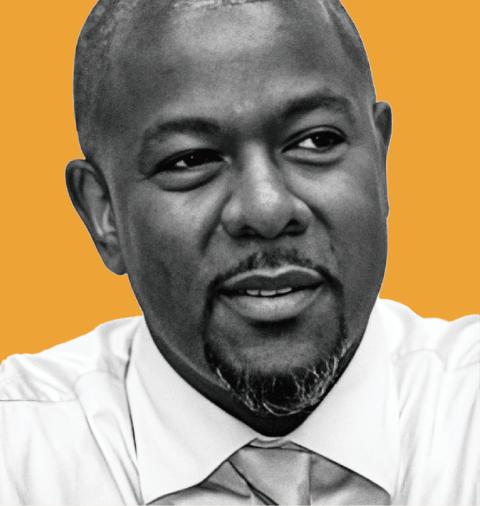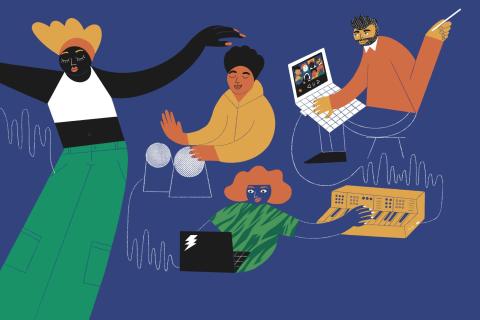Key Changes: Music Educators Change Curricula to Meet Kids Where They Are

Illustration by Helena Pallarés
Playing “Hot Cross Buns” on a recorder is nearly universal in American elementary school music curricula. But the simple tune sounds a little different in the classroom of Patrick Pate B.M. ’08, M.M. ’22.
That’s because, in an attempt to appeal to his fourth-grade students’ more modern tastes, Pate created a collection of reggae-style beats—heavy on the bass—that he plays during their first foray into woodwind instruments.
Instead of dismissing the original melody as too childish, they hear the accompanying track and say, “‘Ohhh, I like this groove,’” says Pate, who works at the Carroll School, a private school for students with language-based learning differences. The basic B-A-G arrangement is suddenly more appealing.
That’s the idea.
An awareness of the need to meet students where they are—culturally and developmentally—has been a major change in pre-K–12 music education in recent years, part of a broader shift in society and in education more generally to prioritize diversity, equity, and inclusion.

Rhoda Bernard
“We’re not just teaching about dead white guys anymore,” says Rhoda Bernard, assistant chair of Berklee’s Music Education Department and managing director of the Berklee Institute for Accessible Arts Education, which provides programs, support, and resources to expand opportunities for people with disabilities in all aspects of performing and visual arts education. “Our [Berklee] students need to know and listen to and appreciate and understand the music their K–12 students are interacting with.”
Pate’s efforts are emblematic of another trend as well, one that was accelerated by the global pandemic: an increasing incorporation of technology into music instruction. In addition to teaching traditional music education staples, such as singing, playing instruments, and movement, Pate regularly includes assignments on Soundtrap, an online digital audio workstation (DAW) that lets students create and record their own music.
New Standards
The importance of music education was legally enshrined in the 2015 Every Student Succeeds Act, which included music instruction in the definition of a “well-rounded education.” And though the law, signed by President Barack Obama, set a national standard, in practice its implementation looks vastly different from state to state and even from district to district, depending on tax revenues, budget priorities, and parent and school board preferences. Still, across the country, schools have generally tried to expand their musical offerings, says Cecil Adderley, chair of Berklee’s Music Education Department. TV shows like Glee and musicals like Hamilton led to an increase in show choirs and musical theater classes. Teachers have also started mariachi ensembles, modern bands, and hip-hop groups.

Cecil Adderley
“The beauty of those ensembles is that you can serve a lot of kids with one teacher,” Adderley says. “That’s provided opportunities for students who might not be interested in traditional band or orchestra.”
John Kendall B.M. ’93, a teacher at Sarasota Middle School, has seen this happen firsthand. About three years ago, he created a modern band class through the nonprofit Little Kids Rock (now known as Music Will), which offers free instruction and instruments to public school districts across the country. The class has proved popular—demand exceeds the approximately 22 spots each year—but his choir, traditional band, and orchestra classes remain full, with about 110, 120, and 30 students each, respectively.
In other words, the modern band course isn’t taking students away from more conventional music classes. Instead, it draws in “a different clientele,” Kendall says.
Making Connections
Greater awareness of the need to connect with students across different ethnic, socioeconomic, and learning backgrounds is also growing. In 2022, Markeise R. Russell B.M. ’15 returned to the high school he had attended to become its assistant principal for teaching and learning. When he was enrolled at Chicago’s Saint Patrick High School between 2007 and 2011, he had been one of the only Black students; today, he is the first Black administrator to lead the 162-year-old school, which now has a majority Latino population. One of his goals for the choir he leads—which grew from four kids to 30 in his first year—is to incorporate different styles of music in the “name of promoting student voice and student choice.”
“One thing I notice about this generation is they like to take ownership of things,” he says.

Markeise Russell B.M. '15
Other teachers are making similar pushes. When Pate worked in the Framingham Public Schools, he highlighted the history of African American music and its impact on other genres. Likewise, Katelyn Downey M.A. ’21, a music teacher in the Quincy Public Schools, teaches her students songs to celebrate Chinese New Year and dances from India (with the help of YouTube).
Jason Patera ’98, head of school at the independent Chicago Academy for the Arts, says Berklee taught him that any genre of music can be studied and pursued with rigor and integrity. He pointed out that his school’s most recent showcase featured performances in ballet, classical music, and Shakespeare as well as a finale featuring two singers—jazz and classically trained—who performed the Imagine Dragons song “Enemy,” written by Justin Tranter ’01 (Tranter is also a graduate of the Chicago Academy for the Arts).
“It was absolutely amazing,” Patera says. “And it underscored how legitimate even the study of pop music can be and at the same time how transformative for both students and the audience.”
In addition to including a variety of musical styles in their curricula, teachers and administrators are working to open music education to a wider student population.

Jason Patera ’98
Making music accessible to students with disabilities is the goal of the Berklee Institute for Accessible Arts Education. “A lot of the students in our graduate programs in music education and autism come to us already with a teaching job,” Bernard, who founded and directs the institute, explains. “They have been working with students with disabilities and want to do better or they love that work so much that they want to devote more time to it.” The Master of Music in Music Education (Autism Concentration) and Graduate Certificate in Music Education and Autism are the only programs of their kind.
Meeting students where they are has long been a priority for Berklee music education graduates. But the profession in general has struggled to keep up with changes in schools and students. According to a new report from the National Association for Music Education, coedited by Adderley, there is a general lack of diversity among music educators, and substantial barriers continue to prevent prospective educators from entering the field or from staying in the classroom beyond a few years. The report offers potential ways to mitigate those barriers at various stages in a person’s career.
“The demographics of the students we serve are changing; the interests of students we serve are changing, and yet the teaching workforce isn’t necessarily changing as fast as the student population,” Adderley says. “What’s keeping people who are interested in arts education out?”

Digital Aids and Challenges
Bringing more technology, including the internet, into the classroom has also been instrumental in keeping music education relevant, engaging, and, in the case of the pandemic, possible. When COVID-related shutdowns began, Downey, like other educators across the world, had to find ways to teach—and reach—her K–8 students.
“For the first three weeks, nobody was really expecting anything of me,” she recalls. “I took it upon myself to make mini lessons on YouTube: ‘Here’s a steady beat; here’s an instrument you can make at home; sing along with these words; here’s a metronome.’”

Katelyn Downey M.A. ’21
Others also learned on the fly. “Music teachers became film editors, sound engineers, recording engineers, and therapists—virtually overnight,” Russell says. “We learned to utilize technology in ways we never had to before.”
Those technological resources remained a mainstay for teachers once in-person classes resumed. But the ubiquity of technology—and smartphones and social media in particular—has proved challenging as well.
“The more digital everyone’s playtime has become—as an educator, your sales pitch better be good,” Pate says with a laugh. “You’re dealing with shorter attention spans than ever before.”
Kendall says he confronts similar issues in his Florida middle school. “This technology is a part of their lives forever at this point,” he says. “How do we find a balance so that we can actually get something done?”
Sonjah Hawkins B.M. ’88 has been teaching at the Renaissance High School for the Arts in Long Beach, California, since 2005. She says she thinks the pandemic heightened a shift in which students are more introverted in person, even if they lead very active online lives.
“We have a lot more visual artists,” she says. “We still have performing artists, but not as many. Students prefer to draw and not have to communicate with people. They have this facade of who they are—they’d much rather be online talking with people.”
Long-Term Impact
Just as pre-K–12 music curricula varies across districts, so does funding. In Sarasota County, Florida, where Kendall teaches, arts are broadly supported throughout the community (the school district has a partnership with the John F. Kennedy Center for the Performing Arts).
“Funding has never been an issue,” he says. “‘Let’s think about cutting arts’ is something you would never say in this district if you want to stay in this district.”
Russell, on the other hand, spent time in the Chicago Public Schools, where he regularly had to solicit grants to fund his students’ instruments and efforts.
“I grew up Catholic—I know how to fund-raise,” he jokes. “But there came a point in my career as a classroom teacher and band director where I was trying to give my kids experiences and I thought, ‘The more I do this, the more there’s going to be an expectation of me to fund my own existence.’”
Russell says one reason he became an administrator is to have a seat at the table where funding decisions are made.
“My voice was not loud enough from my classroom,” he says. “I had to constantly fight and beg for every resource I had. I’m excited to be in the administrative world [to help others see] that arts education is central” to education in general.
For all the challenges and changes, the rewards of teaching music in elementary and secondary schools remain the same: the chance to have an impact on children’s lives.
Kendall says he can remember his elementary school music teacher bringing in a Moog synthesizer as part of a unit on popular music, a rare offering at the time.
“It changed my life,” he says.
Now, Kendall regularly hears from former students who tell him he changed theirs. Their comments, he says, make him feel like “I must be doing something right.”
Russell was also drawn to the power of music to influence young people’s lives. He describes his childhood as “rough” and says he would not be where he is today—studying for a doctorate, helping lead his alma mater—if it weren’t for music, and, especially, music teachers.
They “saw something in me that I did not see in myself ” at the time, he says. “I am living proof of the transformative power of music education.”




